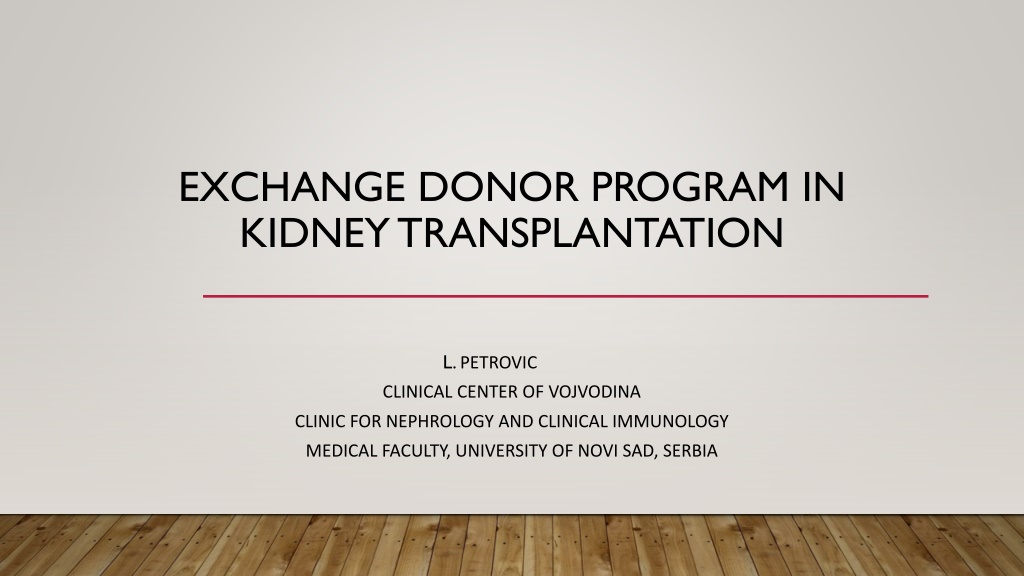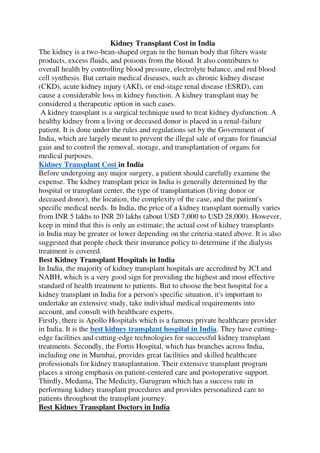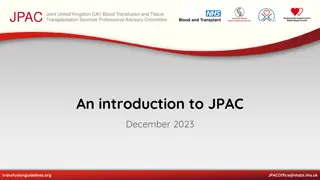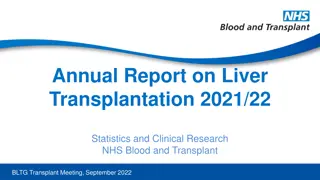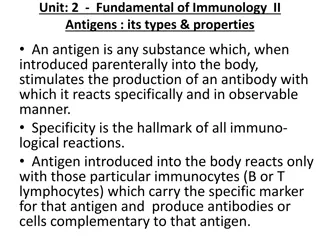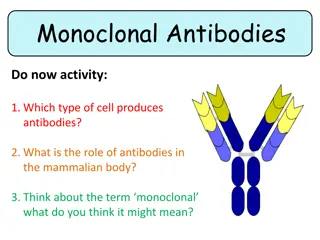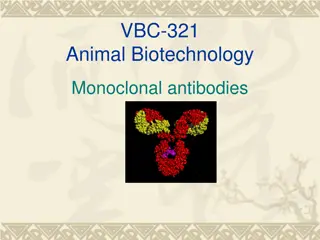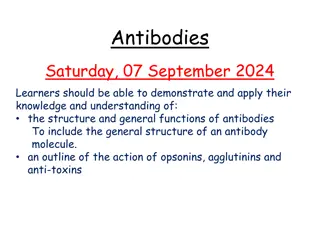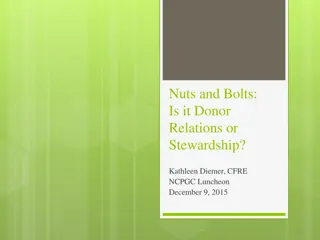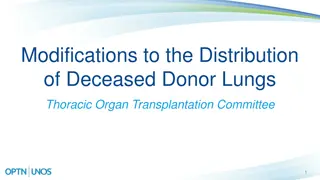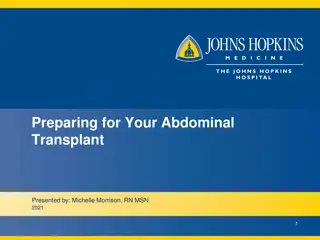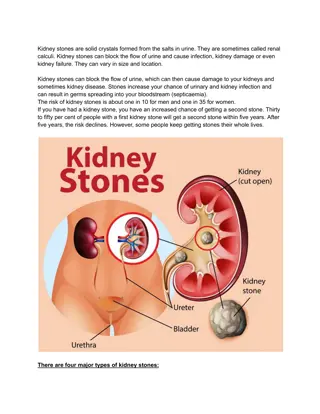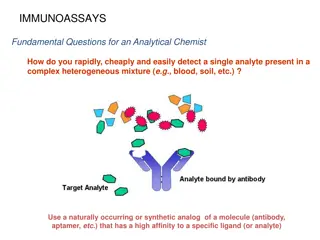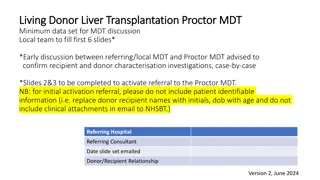Understanding Donor-Specific Antibodies in Kidney Transplantation
Antibodies against antigens in the major histocompatibility complex play a crucial role in kidney transplant rejection. Different types of donor-specific antibodies can lead to rejection at various stages post-transplantation. Methods to discover donor-specific anti-HLA antibodies include complement-dependent cytotoxicity and flow cytometric crossmatches. Novel parameters like vPRA, cPRA, and cRF help estimate the chance of successful transplantation in sensitized patients. Recommendations emphasize the importance of using HLA frequencies to match donors and recipients effectively in highly sensitized patients.
- Kidney Transplantation
- Donor-Specific Antibodies
- HLA Mismatch
- Transplant Rejection
- Sensitized Patients
Download Presentation

Please find below an Image/Link to download the presentation.
The content on the website is provided AS IS for your information and personal use only. It may not be sold, licensed, or shared on other websites without obtaining consent from the author. Download presentation by click this link. If you encounter any issues during the download, it is possible that the publisher has removed the file from their server.
E N D
Presentation Transcript
EXCHANGE DONOR PROGRAM IN KIDNEYTRANSPLANTATION L. PETROVIC CLINICAL CENTER OF VOJVODINA CLINIC FOR NEPHROLOGY AND CLINICAL IMMUNOLOGY MEDICAL FACULTY, UNIVERSITY OF NOVI SAD, SERBIA
ANTIBODIES AGAINST ANTIGENES IN THE MAJOR HISTOCOMPATIBILITY COMPLEX (MHC) ANTI-HUMAN LEUKOCYTEANTIGEN (antiHLA) DONOR-SPECIFIC ANTIBODIES (DSA) Rejection caused by antibodies is one of the main reasons for losing a graft after a kidney transplant. Donor-SpecificAntibodies (DSA) are one of the biomarkers of this process.
DSA TYPES 1. DSA developted before kidney transplant, so called preformed antibodies a. Hyperacute rejection, b. Accelerated acute or c. Early acute antibody-mediated rejection 2. De novo DSA a) late acute antibody-mediated rejection, b) chronic antibody-mediated rejection c) grapht glomerulopathy 3. Benign DSA has no clinical value, because they are not combined with antibody-mediated rejection or graft loss.
METHODS DISCOVERING DONOR-SPECIFIC ANTIHLA ANTIBODIES (DSA) Complement-dependent cytotoxicity (CDC) the gold standard measure of HLA antibodie expressed as a percentage of panel reactive antibodies (%PRA) a PRA > 85% was considered the threshold for a highly sensitized patient the Flow Cytometric crossmatch (FCM) clinically relevant a risk factor Solid phase assays Single antigen beads (SAB) - detection and identification of specific HLA antibodies mean fluorescence intensity (MFI)
NOVEL PARAMETERS vPRA (virtual PRA) cPRA (calculated PRA) cRF (calculated reaction frequency) ***They all reflect a chance that a patient has HLA antibodies reactive with a donor derived from the actual organ donor population HLA incompatible transplantation (HLAi) HLA incompatible transplantation (HLAi) is defined by a positive CDC or FCM crossmatch at baseline is defined by a positive CDC or FCM crossmatch at baseline
RECOMMENDATIONS A parameter, which is based on the HLA frequencies of the actual organ donor population, such as vPRA, cPRA or cRF, should be used to estimate the chance that a sensitized patient can be transplanted with a compatible donor without the need for any special treatment (1C). When defining unacceptable mismatches in highly sensitized patients on the basis of (weak) antibody reactivities in single antigen bead assays only, one should consider the poorly defined risk of antibody-mediated rejection (ABMR) in the light of a prolonged waiting time and associated mortality and morbidity (2D)
AREAS FOR FURTHER RESEARCH Further standardization of single antigen bead assays and their interpretation is recommended (1C). Better HLA matching on the basis of antibody epitopes rather than antigens and a restricted transfusion policy will probably diminish the number of highly sensitized patients, but more data is needed.
RECOMMENDATIONS ORGAN ALLOCATION We recommend an active policy of prioritizing highly sensitized patients for organ transplantation, using cPRA/ cRF
THE PLACE OF KIDNEY EXCHANGE PROGRAMS FOR HIGHLY SENSITIZED PATIENTS The closed loop- between two, three or more incompatible pairs whose recipients find a compatible kidney by exchanging their donors, represents another basic form of kidney paired donation.
A NON-DIRECTED ALTRUISTIC (OR UNSPECIFIED) DONOR (NDAD) DECEASED DONOR KIDNEY PAIRED EXCHANGE (DEC-K) PROGRAM
List exchange (Delmonico et al.) Novel KEP schemes take place in the setting of chronological incompatibility Including ABO or HLA compatible pairs in KEP Trans-organ paired exchange = represents the most innovative concept of KEP
RECOMMENDATIONS Increased access to and harmonization of kidney exchange programs with greater and standardized sharing of outcomes (1C) Inclusion of unspecified kidney donations (if these are performed) in kidney exchange programs (1C) Inclusion of compatible pairs and deceased donor organs in kidney exchange programs (1C) Entering a kidney exchange program is the preferred initial option over desensitization given the better transplant outcomes and cost-effectiveness, unless there is a need for desensitization, there is clinical urgency or a low chance of a transplant (1C)
KEP ADVANCES RELATED TO DESENSITIZATION Desensitization treatments are expensive might have related complications and inferior long-term consequences in comparison to KPD Kidney exchange transplantation is a fast-rising modality for allowing living associated donor kidney transplantation (LDKT) for patients who are incompatible with their healthy, willing, and living donors More suitable in countries where deceased donor kidney transplantation rates and ABO-incompatible transplantation are not available or are very low HLA matched KEP needs less immunosuppression and fewer costs, has lower infective problems and good survival rate, mainly in developing countries KEP is a significant source to rise in the donor pool to avoid profitable transplantation Kidney exchange transplantation offers good quality organs and is highly used in developed and developing countries
ALGORITHM OF OPTIONS FOR A HIGHLY SENSITIZED TRANSPLANT CANDIDATE
KEY CHARACTERISTICS THAT DEFINE KEP EFFECTIVENESS: a transparent, objective, and responsible donor selection system, including both physical and psychological screening; consistent and responsive systems and processes including matching software, immunological testing, organizational framework, and central coordination; clinical leadership to establish confidence in the KEP as the treatment of choice for immunologically complex recipients and compatible recipient-donor pairs seeking a better age or HLA match and to ensure that recipients and donors are appropriately informed about their treatment options; recipient and donor awareness to inform their decision making and encourage participation in the KEP; a centralized follow up system, to monitor the effectiveness of the program in terms of the impact on the donor and recipient, and more generally in terms of overall outcomes; a strive for continuous improvement in development of the KEP in response to innovations in the field, clinician, and patient choice, and to actively manage potential risks (eg, diminishing pool size, nonproceeding transplants, low uptake of the KEP
THERE ARE ESSENTIALLY 3 WAYS OF IMPROVING THE PERFORMANCE OF THE KEPS: 1. Extending the national pools: Reaching full coverage in the national KEPs through the participation of all the transplant centers. Inclusion of compatible pairs to achieve better HLA or age match for the recipients involved and generating more exchange opportunities for other recipients. Inclusion of HLA incompatible pairs in preference to antibody removal, and inclusion of ABO incompatible pairs to avoid the costs and higher risks associated with desensitization programs (at least by registering them for a number of runs in the KEP before choosing these alternative treatments). Inclusion of altruistic (unspecified) donors to trigger KEP chains, where the transplants can be nonsimultaneous and in the form of long or never ending chains. Allowing multiple potential donors to register for 1 patient to improve the chances of identifying exchange cycles 2. Allowing new modalities in the exchange, 3. Increasing international cooperation.
